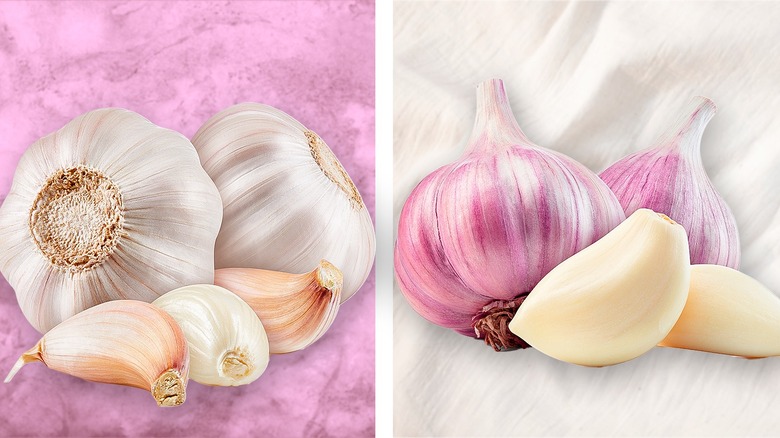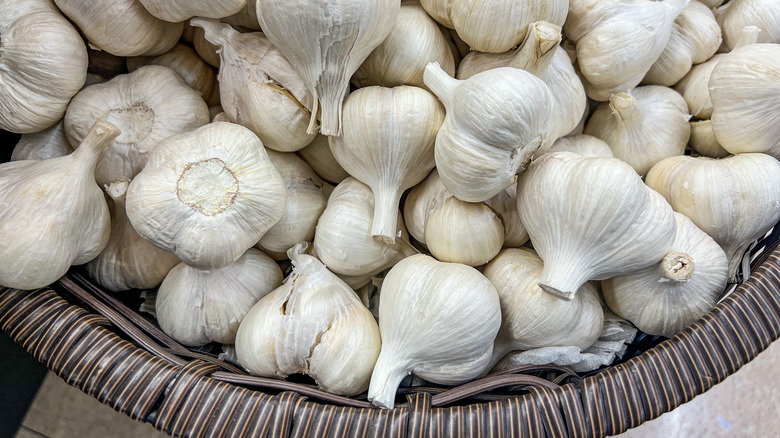The Flavor Difference Between Classic And Purple Garlic
You're in a grocery store or farmer's market reaching for the usual bulb of fresh garlic cloves, when suddenly you see a glimmer of purple. No, that's not a blemish, a trick of the eye, or a wonky overhead light source. It's genuine purple garlic, and you definitely want to try it. The violet hues only appear in the papery exterior skin, typically in splotches or stripes, cloaking white or ivory interior bulbs similar to those in standard garlic. But don't let appearances fool you. These are not the same types of garlic bulbs, especially when it comes to flavor.
Purple garlic is a hardneck garlic, which is actually a different variety than softneck white garlic. A sturdy stalk grows through the middle of these pungent purple beauties, resulting in uniform bulb sizes and the so-called hard necks. Though bolder in appearance, the flavor of hardneck garlic is different than that of softneck garlic. Classic white garlic comes on strong, letting its presence be known in a big way, while its purple counterpart carries a more subtle persona in recipes. It's gentler and somewhat mild.
Some chefs also consider purples to be sweeter and more aromatic, depending on the variety, which elevates the dining experience. After all, taste and smell are intricately intertwined in the sensory experience of eating. Even more enticing, purple garlic comes in several types, each with their own nuanced flavor characteristics. Depending on availability, you may just be opening an entirely new page in your personal repertoire of garlic flavors.
Enhancing recipes with white versus purple garlic
Most chefs, whether professional or home kitchen gurus, are familiar with the earthy, pungent taste of white garlic, a go-to component of countless dishes, both cooked and raw. Either way, the flavor is generally prominent and defining. Given this common perception and the pervasive use of white garlic, it serves as a useful springboard for comparing it with purple garlics. Dozens of purple garlic varieties exist, some regional, heirloom, organic, or other distinctions, and others called red garlic instead of purple.
One of the most common is Italian Purple garlic, which carries flavors that transition when going from raw form to cooked. It's an excellent choice for salads, dressings, salsas, and other uncooked savory foods, enriching them with mildly sweet, full-bodied flavors and a slight spicy kick. However, in cooked dishes, the Italian Purple increases in sweetness and mellows out considerably. Another purple variety with a rich, full-bodied persona — plus nutty undertones — is the Killarney Red, a favorite with commercial kitchen chefs.
Purple garlics and classic whites are mostly interchangeable in garlic-centric recipes, including creamy garlic butter noodles and garlic-based sauces. But purples are especially well-suited for roasted garlic recipes, either prepared in the oven or on the outdoor grill. Choosing purple over white can amplify the flavor of roasted garlic, resulting in a rich, sweet, power-packed snack, appetizer, or side dish. Purples can also transform a whole roasted chicken; just slice off the tops and bottoms of several full garlic bulbs and stuff them into the bird's cavity.

